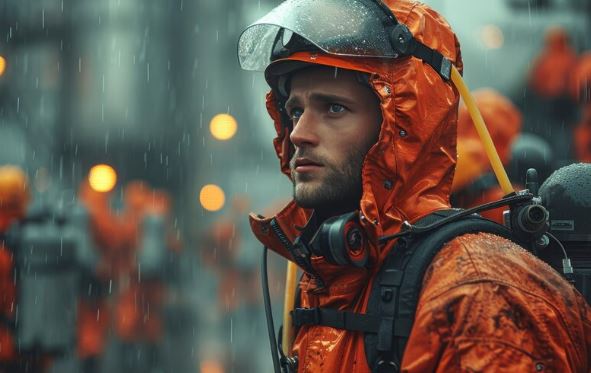Did you know that, according to Safe Work Australia, over 1,000 workplace injuries occur annually due to poor visibility in bad weather? Unpredictable Australian weather conditions can be a recipe for disaster, especially when working outdoors or enjoying your favourite activities. Here’s where hi-vis rainwear in Australia steps in as your trusty companion. This crucial piece of gear goes beyond keeping you dry; it ensures your safety in any downpour by making you highly visible to others.
The Evolution of Hi-Vis Rainwear in Australia
The story of hi-vis rainwear in Australia is one of innovation and adaptation. It was primarily basic protective gear in the early days, often bulky and uncomfortable. Think stiff yellow jackets made from PVC or rubberised materials. These early iterations offered basic protection from the elements but lacked breathability and flexibility.
- Material and Design Advancements: Fast forward to today, and hi-vis rainwear has undergone a remarkable transformation. Modern materials like PU-coated polyester and breathable mesh linings offer superior waterproofing while allowing for better airflow and comfort. Additionally, advancements in reflective technology have led to brighter, more durable reflective strips that enhance visibility in low-light conditions.
- Fashion Meets Function: Gone are the days when hi-vis rainwear was purely utilitarian. Today, it’s a style statement in its own right. Manufacturers are incorporating reflective elements into sleek, modern designs, catering to a wider audience. Whether you’re a construction worker or a cyclist, you can find hi-vis rainwear that keeps you safe and looking sharp.
Choosing the Right Hi-Vis Wet Weather Gear
Types of Rainwear
The Australian market offers a diverse range of hi-vis wet weather gear to suit various needs and budgets. Here’s a breakdown of some popular options:
- Pacmacs: These lightweight, disposable ponchos are perfect for short bursts of rain. They’re compact and easily stored in a backpack or bag.
- Pocket Raincoats: As the name suggests, these raincoats are highly portable, folding down into a pocket-sized pouch. They offer a good balance between portability and protection from sudden downpours.
- Workwear Rain Jackets: Designed for durability and functionality, workwear rain jackets are ideal for those who work outdoors regularly. They often feature multiple pockets, reinforced seams, and heavier construction for withstanding tough conditions.
- Hi-Vis Raincoats: These raincoats combine the high visibility of hi-vis clothing with waterproof protection. They come in various lengths, styles, and features, making them a versatile choice for professional and personal use.
Selection Factors
Choosing the right hi-vis rainwear goes beyond just picking a bright colour. Here are some key factors to consider:
- Durability: Consider the frequency and intensity of the rain you’ll be facing. Workwear rain jackets offer superior durability compared to lightweight pocket raincoats.
- Breathability: This is crucial for comfort, especially during extended wear. Look for raincoats with breathable materials like mesh linings to prevent overheating.
- Level of Visibility: Ensure the hi-vis rainwear complies with relevant Australian standards (refer to AS/NZS 1906:2010) for the visibility required for your activity.
- Comfort Features: Look for features that enhance comfort, such as adjustable hoods, ventilation zips, and ergonomic designs that allow for freedom of movement.
- Compliance with Regulations: For certain professions like construction or traffic control, specific hi-vis clothing regulations may apply. Ensure your rainwear meets these requirements.
Popular Options Compared
Choosing the right hi-vis rainwear goes beyond just picking a bright color. Here’s a breakdown of the key differences between the three most popular options to help you find the perfect fit:
- Portability: Pocket raincoats are the clear winner for portability, easily folding down into a compact size for stashing in a backpack or bag. Workwear rain jackets offer the least portability due to their heavier construction. Hi-vis raincoats fall somewhere in the middle, with varying degrees of packability depending on the design.
- Durability: Workwear rain jackets reign supreme in terms of durability, built to withstand the wear and tear of frequent use in harsh conditions. Pocket raincoats are typically less durable due to their lightweight materials. Hi-vis raincoats offer a range of durability levels depending on the construction, with some being more on par with workwear jackets and others closer to pocket raincoats.
- Breathability: For maximum comfort during extended wear, breathability is crucial. Pocket raincoats often offer moderate breathability, while workwear rain jackets can be less breathable due to their heavier materials. Hi-vis raincoats come in a variety of breathability options, so you can find one that balances visibility with comfort for your specific needs.
- Visibility: Hi-vis raincoats are the undisputed champion of visibility, featuring bright fluorescent colours and reflective strips designed to maximise your presence in low-light conditions. Pocket raincoats and workwear jackets may offer some level of visibility, but they won’t be as prominent as a dedicated hi-vis option.
- Price: Pocket raincoats are generally the most affordable option due to their simpler construction. Workwear rain jackets and hi-vis raincoats can range in price depending on features, materials, and brand, but generally fall within a moderate to high price range.

Tips for Proper Maintenance and Care
Just like any other gear, proper maintenance is essential to maximise the lifespan and performance of your hi-vis rainwear. Here are some tips:
Importance of Maintenance
Regular cleaning and maintenance ensure your hi-vis rainwear retains its waterproofing capabilities and reflective properties. Neglected rainwear can become less effective over time, compromising your safety.
Cleaning and Storage
- Avoid harsh chemicals, bleach, or fabric softeners, as they can damage the waterproof coating and reflective materials.
- Turn the rainwear inside out before washing.
- Rinse thoroughly with clean water to remove any detergent residue.
- Hang dry your rainwear in a well-ventilated area away from direct sunlight. Excessive heat can damage the fabric and its reflective properties.
- When not in use, store your hi-vis rainwear in a cool, dry place, preferably hanging on a hanger to prevent creases and maintain its shape.
Inspection and Repair
- Regularly inspect your rainwear for any signs of damage, such as rips, tears, or worn-out seams.
- Minor repairs like patching small holes or replacing buttons can often be done at home with basic sewing skills.
- For more significant repairs, consider taking your rainwear to a professional tailor or seamstress specialising in outdoor gear.

Hi-Vis Rainwear for Different Professions
Specific Professions
For many professions in Australia, hi-vis rainwear is not just a choice; it’s a mandatory safety requirement. Here are some examples:
- Construction Workers: Exposed to the elements throughout the workday, construction workers need durable hi-vis rainwear that can withstand harsh weather conditions. Look for jackets with reinforced seams, multiple pockets for tools, and a longer length for added protection.
- Road Workers: Working near moving traffic requires high visibility. Choose hi-vis raincoats with a full hood and bright reflective strips that ensure you’re seen from all angles. Opt for breathable materials to avoid overheating during long shifts.
- Emergency Responders: Firefighters, paramedics, and other emergency personnel need hi-vis rainwear that allows for maximum mobility. Opt for lightweight, flexible jackets with features like articulated elbows and knees for unrestricted movement.
- Mining Personnel: Mining environments can be wet and unpredictable. Choose hi-vis rainwear with flame-retardant properties for added safety.
- Traffic Control Officers: Directing traffic in the rain demands high visibility. Look for hi-vis raincoats with a bright fluorescent yellow or orange base colour and wide reflective stripes.
Job Requirements and Recommendations
Beyond the general considerations, specific job requirements should influence your hi-vis rainwear choice. Here’s an example:
- Construction Worker in Cold Climates: In addition to the features mentioned earlier, consider a hi-vis rain jacket with a removable thermal liner for added warmth in cold weather.
Regulations
Remember, some professions have specific regulations regarding hi-vis clothing compliance. Always check with your employer or relevant governing body to ensure your rainwear meets the required Australian Standards (AS/NZS standards) for visibility and other safety features.

Hi-Vis Rainwear for Outdoor Enthusiasts
Enhanced Safety and Comfort
For outdoor enthusiasts like hikers, campers, fishermen, and cyclists, hi-vis rainwear is an essential piece of safety equipment. It ensures you’re visible to other hikers, motorists, and emergency services, especially in low-light conditions or during foggy weather. This can significantly reduce the risk of accidents and mishaps. Additionally, hi-vis rainwear offers reliable protection from the elements, keeping you dry and comfortable throughout your adventure.
Features for Adventure
When choosing hi-vis rainwear for outdoor activities, consider these features:
- Packability: Look for raincoats that fold down into a compact size and easily fit into your backpack. Lightweight and packable options are ideal for on-the-go adventures.
- Water Resistance: While complete waterproofing is desirable, breathability is also crucial for comfort during strenuous activities. Look for raincoats with a balance between these functionalities.
- Breathability: As mentioned earlier, breathability allows moisture vapour to escape, preventing you from feeling clammy and uncomfortable during hikes or bike rides.
- Additional Functionalities: Depending on your specific needs, consider features like built-in insect repellent for bug protection or integrated gloves for added warmth and dexterity.

Advanced Features for Hi-Vis Rainwear
While core functionalities like waterproofing and visibility are paramount, modern hi-vis rainwear offers a range of advanced features to enhance comfort, safety, and functionality for various user needs. Here’s a closer look at some of these advancements:
- Seam Sealing: This technique involves applying a waterproof sealant to the seams of the rainwear, preventing water ingress through stitch holes, and ensuring complete protection from the elements.
- Ventilation Systems: Strategic placement of vents allows for improved breathability and moisture management. This is crucial for activities that involve exertion, preventing overheating and discomfort. Look for features like pit zips or back mesh panels for optimal airflow.
- Reflective Tape Configurations: Hi-vis rainwear goes beyond the standard reflective stripes. Advanced configurations like segmented taping or chevron patterns offer enhanced visibility from different angles, which is significant for low-light conditions and increased traffic zones.
- Detachable Features: Some rainwear offers detachable features like sleeves or hoods, providing versatility for changing weather conditions. This allows for a lighter-weight option during mild rain and full coverage when needed.
- Touchscreen Compatibility: For those who rely on smartphones or GPS devices while working outdoors, rainwear with touchscreen-compatible fingertips on the sleeves or integrated transparent pockets allows for easy interaction without compromising protection.
Thermal Insulation: For colder climates or extended exposure to rain, hi-vis rainwear with integrated thermal insulation layers provides additional warmth and comfort. This can be achieved through fleece linings or removable insulated liners. - Ergonomic Design: Well-designed hi-vis rainwear incorporates ergonomic features like articulated elbows and knees for improved freedom of movement. This is especially important for professions that require a high degree of mobility, such as construction workers or emergency responders.

Sustainable Practices in Hi-Vis Rainwear
As environmental consciousness grows, manufacturers are developing hi-vis rainwear with sustainability in mind. Here are some examples:
- Recycled Materials: Using recycled polyester or nylon in the construction of rainwear reduces the environmental impact of production.
- PFC-Free Waterproofing: Traditional waterproofing treatments often contain harmful Perfluorinated Chemicals (PFCs). Opting for PFC-free alternatives ensures environmental protection without compromising performance.
- Durable Construction: Investing in high-quality, well-made hi-vis rainwear extends its lifespan, reducing waste and the need for frequent replacements.

Maintaining Your Hi-Vis Rainwear for Optimal Performance
Following proper cleaning and maintenance practices is essential to ensure your hi-vis rainwear remains effective for extended periods. Here are some additional tips beyond the basics:
- Spot Cleaning: For minor dirt or stains, address them promptly using a damp cloth and a mild detergent. Avoid harsh chemicals that can damage the fabric or reflective materials.
- Re- waterproofing: Over time, the water-repellence of the rainwear can diminish. Consider using a fabric-proofed spray specifically designed for outdoor gear to restore its effectiveness.
- Reflective Tape Replacement: If the reflective strips become damaged or lose their shine, consider replacing them with sew-on or iron-on reflective tape to maintain optimal visibility.

Conclusion
Australia’s unpredictable weather can pose a serious threat, especially if you work outdoors or enjoy outdoor activities. Hi-vis rainwear plays a critical role in keeping you safe by ensuring you stay dry and highly visible in low-light conditions. Remember to not underestimate the power of a simple rain jacket; it could be the difference between a safe and enjoyable experience and a potentially hazardous situation. Investing in quality, certified hi-vis rainwear is an investment in your safety. Look for rainwear that complies with relevant Australian Standards (AS/NZS 1906:2010) to ensure it meets the required level of visibility. Remember, hi-vis rainwear is not a fashion statement; it’s a crucial piece of safety equipment. Stay dry, stay visible, and stay safe with the right hi-vis rainwear!